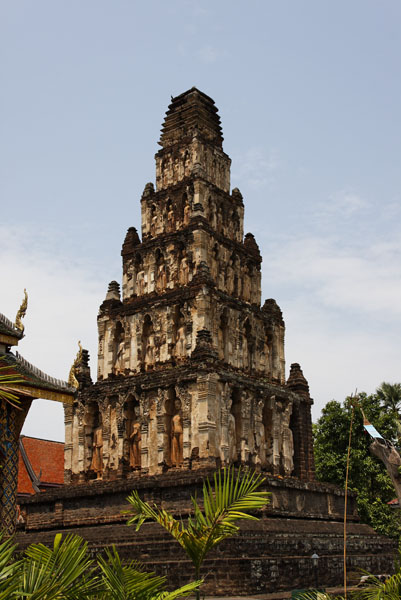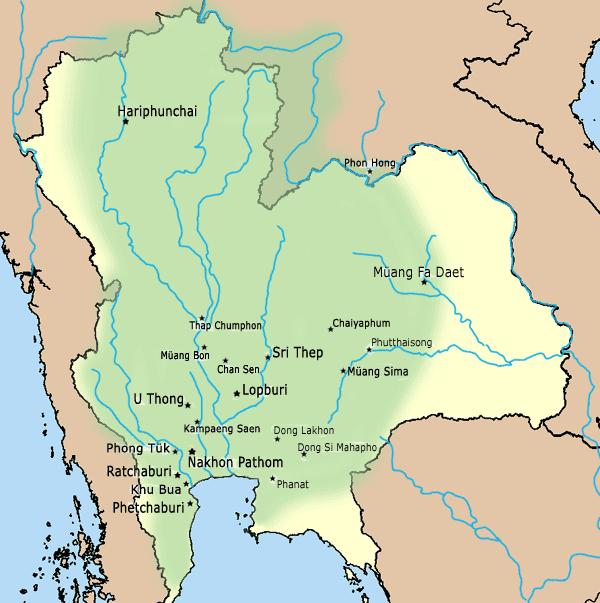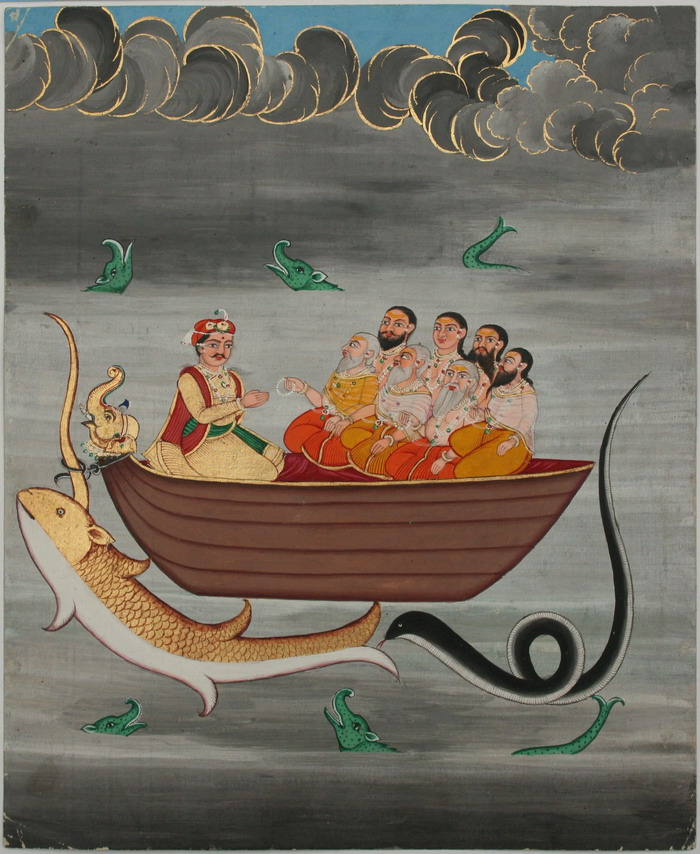|
Cāmadevivaṃsa
The Camadevivamsa (, , literally, "Chronicle of the Lineage of Cāmadevi") is a Pali chronicle composed in the early 15th century by the Lanna Buddhist monk Mahathera Bodhiramsi (). The chronicle, dated to c. 1410, is a semi-historical recounting of the founding of the Mon people, Mon Dvaravati kingdom of Hariphunchai (Haripunjaya) in the mid-sixth century by Camadevi, Queen Cāmadevi and her establishment of a lineage destined to rule Haripunchai for the next 500 years. The manuscript ends with King Adittaraja's discovery of a sacred relic of the Buddha in the eleventh century that became central to the Theravada Buddhist culture of Haripunchai and is still enshrined in Wat Phradhatu Haripunjaya (Wat Phra That Hariphunchai) in present-day Lamphun, Thailand. In addition to the Camadevivamsa, which is also known in English as ''The Legend of Queen Cama'' and ''The Chamadevivongs'', Bodhiramsi also composed, in 1417, the ''Tamnan Phraphutthasihing'', another chronicle which describes t ... [...More Info...] [...Related Items...] OR: [Wikipedia] [Google] [Baidu] |
Camadevi
Camadevi (also spelled Jamadevi; IPA: [tʃaːmaˈdeːʋiː]; Pali: Cāmadevī; , , Mon: စာမ္မာဒေဝဳ, ; 7th-century – 8th-century) was the first monarch and Queen of Haripuñjaya, Hariphunchai (Pali: Haribhuñjaya), which was an ancient Suvarnabhumi, Kingdom in the Northern part of nowadays Thailand before its united with the Sukhothai Kingdom, Kingdom of Sukhothai, the first Thai Kingdom. Most records of Camadevi mention her life period differently. For example: A book called ''“Jinakalamali, Chinnakanmalipakon”'' said that she reigned in 662 for 7 years; Manit Wallipodom's research mentioned that she was born in 623, reigned in 662 for 17 years and died in 715 at the age of 92; and The legend of Camadevi translated and edited by Suttavari Suwannapat mentioned that she was born in 633, reigned in 659 up til 688 and died in 731. Early life As written in the Legend of Cāmadevivaṃsa, it was recorded that she was a scion of the ruler of Lavo Kingdom. But a ... [...More Info...] [...Related Items...] OR: [Wikipedia] [Google] [Baidu] |
Lavo Kingdom
The Lavo Kingdom () was a political entity (Mandala (Southeast Asian political model), mandala) on the left bank of the Chao Phraya River in the Upper Chao Phraya valley from the end of Dvaravati civilization, in the 7th century, until 1388. The original center of Lavo was Lopburi, Lavapura and was shifted to Ayodhya (Xiān) in the 1080s. However, since both Ayodhya or Xiān and Lavo separately sent embassies to the Chinese court in the late 1200s, these two polities were potentially individual states. Before the 9th century, Lavo, together with other supra-regional settlements, such as Si Thep Historical Park, Si Thep, , Phimai Historical Park, Phimai, Nakhon Pathom, and others were the centers of the Mandala (political model), mandala-style polities of Dvaravati. Due to several circumstances, including climate changes and the invasions of the surrounding polities, several Dvaravati centers lost their prosperity, and the mandalas in the Chao Phraya River, Menam Valley was then s ... [...More Info...] [...Related Items...] OR: [Wikipedia] [Google] [Baidu] |
Mon People
The Mon (; Thai Mon: ဂကူမည်; , ; , ) are an ethnic group who inhabit Lower Myanmar's Mon State, Kayin State, Kayah State, Tanintharyi Region, Bago Region, the Irrawaddy Delta, and several areas in Thailand (mostly in Pathum Thani province, Phra Pradaeng and Nong Ya Plong). The native language is Mon, which belongs to the Monic branch of the Austroasiatic language family and shares a common origin with the Nyah Kur language, which is spoken by the people of the same name that live in Northeastern Thailand. A number of languages in Mainland Southeast Asia are influenced by the Mon language, which is also in turn influenced by those languages. The Mon were one of the earliest to reside in Southeast Asia, and were responsible for the spread of Theravada Buddhism in Mainland Southeast Asia. The civilizations founded by the Mon were some of the earliest in Thailand as well as Myanmar and Laos. The Mon are regarded as a large exporter of Southeast Asian cultur ... [...More Info...] [...Related Items...] OR: [Wikipedia] [Google] [Baidu] |
Lawa People
Lawa ( or ; ) are an ethnic group in northern Thailand. The Lawa language is related to the Blang language, Blang and the Wa language found in China and Myanmar (Burma), and belongs to the Palaungic languages, a branch of the Austroasiatic languages. Their population is estimated to be some 17,000. The Western Lawa are found in the vicinity of Amphoe Mae Sariang, Mae Sariang in the south of Mae Hong Son Province, the Eastern Lawa are centred on Bo Luang in Chiang Mai Province. Overview The Lawa are sometimes mistaken for being the same people as the Lua people, Lua of northern Laos and of Nan Province, Thailand, who are speakers of the more distantly related Khmuic languages. This problem is compounded by the Eastern Lawa of Chiang Mai Province preferring to be called Lua by outsiders, and by the Thai people generally referring to speakers of these different Palaungic languages as Lua. Today, those Lawa who have not been integrated in mainstream Thai society, still live a traditi ... [...More Info...] [...Related Items...] OR: [Wikipedia] [Google] [Baidu] |
Phra Phuttha Sihing
The Phra Phuttha Sihing () is a highly revered image of the Gautama Buddha in Bangkok, Thailand, second in importance only after the Emerald Buddha. The image is currently housed at the Phutthaisawan Hall (formerly a part of the Front Palace), now the Bangkok National Museum. The image was brought to Bangkok from Wat Phra Singh, Chiang Mai in 1795 by Viceroy Maha Sura Singhanat, the brother of King Rama I. History The provenance of the Phra Phuttha Sihing image is still in question. The name ''Sihing'' comes from '' Sinhala'' the name of several kingdoms in Sri Lanka. According to legend the Phra Phuttha Sihing image was created in Sri Lanka around 157 A.D. and was brought to Thailand in 1307 to Sukhothai. Later it was relocated to Phitsanulok, Ayutthaya in 1378, Kamphaeng Phet in 1382 and Chiang Rai in 1388, before it was brought back to Ayutthaya again and then back to Chiang Mai in 1407, where it was enshrined at Wat Phra Singh. When King Narai conquered Chiang Mai in 1662, ... [...More Info...] [...Related Items...] OR: [Wikipedia] [Google] [Baidu] |
Pali
Pāli (, IAST: pāl̤i) is a Classical languages of India, classical Middle Indo-Aryan languages, Middle Indo-Aryan language of the Indian subcontinent. It is widely studied because it is the language of the Buddhist ''Pali Canon, Pāli Canon'' or ''Tripiṭaka, Tipiṭaka'' as well as the sacred language of ''Theravada, Theravāda'' Buddhism. Pali was designated as a Classical languages of India, classical language by the Government of India on 3 October 2024. Origin and development Etymology The word 'Pali' is used as a name for the language of the Theravada canon. The word seems to have its origins in commentarial traditions, wherein the (in the sense of the line of original text quoted) was distinguished from the commentary or vernacular translation that followed it in the manuscript. K. R. Norman suggests that its emergence was based on a misunderstanding of the compound , with being interpreted as the name of a particular language. The name Pali does not appear in t ... [...More Info...] [...Related Items...] OR: [Wikipedia] [Google] [Baidu] |
Tai Peoples
Tai peoples are the populations who speak (or formerly spoke) the Tai languages. There are a total of about 93 million people of Tai ancestry worldwide, with the largest ethnic groups being Dai people, Dai, Thai people, Thai, Isan people, Isan, Tai Yai people, Tai Yai (Shan), Lao people, Lao, Ahom people, Tai Ahom, Tai Kassay and Northern Thai people, some Northern Thai peoples. The Tai are scattered through much of South China and Mainland Southeast Asia, with some (''e.g.'' Ahom people, Tai Ahom, Tai Kassay, Khamyang people, Tai Khamyang, Khamti people, Tai Khamti, Tai Phake people, Tai Phake, Tai Aiton) inhabiting parts of Northeast India. Tai peoples are both culturally and genetically very similar and therefore primarily identified through their language. Names Speakers of the many languages in the Tai branch of the Tai–Kadai languages, Tai–Kadai language family are spread over many countries in Southern China, Indochina and Northeast India. Unsurprisingly, there are ... [...More Info...] [...Related Items...] OR: [Wikipedia] [Google] [Baidu] |
Mon History
Mon, MON or Mon. may refer to: Places * Mon State, a subdivision of Myanmar * Mon, India, a town in Nagaland * Mon district, Nagaland * Mon, Raebareli, a village in Uttar Pradesh, India * Mon, Switzerland, a village in the Canton of Grisons * Anglesey, , an island and county of Wales * Møn, an island of Denmark * Monongahela River, US or "The Mon" Peoples and languages * Mon people, an ethnic group from Burma * Mon language, spoken in Burma and Thailand * Mon–Khmer languages, a large language family of Mainland Southeast Asia * Mongolian language (ISO 639 code), official language of Mongolia * Alisa Mon, Russian singer Other uses * Mon (emblem), Japanese family heraldic symbols * Mon (architecture), gates at Buddhist temples, Shinto shrines and castles in Japan * Mon (boat), a traditional war canoe of the North Solomons * Mon (currency), a currency used in Japan until 1870 * Môn FM, a radio station serving Anglesey, Wales * ''The Gate'' (novel) (), a 1910 novel by Natsum ... [...More Info...] [...Related Items...] OR: [Wikipedia] [Google] [Baidu] |
Lan Na Chronicles
Lan or LAN may refer to: Science and technology * Local asymptotic normality, a fundamental property of regular models in statistics * Longitude of the ascending node, one of the orbital elements used to specify the orbit of an object in space * Łan, unit of measurement in Poland * Local area network, a computer network that interconnects within a limited area such as one or more buildings * Lan blood group system, a human blood group * Lanthanum nitride, a chemical compound whose formula is LaN Places * Lan County, Shanxi, China * Łan, Lublin Voivodeship, Poland * Lan (agrotown), agrotown in Nyasvizh district, Minsk region, Belarus * Lan (river), Belarus * Llan (placename), a placename element known in Breton as ''lan'' * LAN ** Chapman code of Lancashire, England ** National Rail station code of Lancaster railway station, England **IATA airport code of Capital Region International Airport, Lansing, Michigan, US Airlines * LAN Airlines, former name of LATAM Chile, an airl ... [...More Info...] [...Related Items...] OR: [Wikipedia] [Google] [Baidu] |
Pali Buddhist Texts
Pāli (, IAST: pāl̤i) is a classical Middle Indo-Aryan language of the Indian subcontinent. It is widely studied because it is the language of the Buddhist ''Pāli Canon'' or '' Tipiṭaka'' as well as the sacred language of '' Theravāda'' Buddhism. Pali was designated as a classical language by the Government of India on 3 October 2024. Origin and development Etymology The word 'Pali' is used as a name for the language of the Theravada canon. The word seems to have its origins in commentarial traditions, wherein the (in the sense of the line of original text quoted) was distinguished from the commentary or vernacular translation that followed it in the manuscript. K. R. Norman suggests that its emergence was based on a misunderstanding of the compound , with being interpreted as the name of a particular language. The name Pali does not appear in the canonical literature, and in commentary literature is sometimes substituted with , meaning a string or lineage. This n ... [...More Info...] [...Related Items...] OR: [Wikipedia] [Google] [Baidu] |
Rishi
In Indian religions, a ''rishi'' ( ) is an accomplished and enlightened person. They find mention in various Vedic texts. Rishis are believed to have composed hymns of the Vedas. The Post-Vedic tradition of Hinduism regards the rishis as "great yogis" or "sages" who after intense meditation (Tapas (Sanskrit), tapas) realized the supreme truth and eternal knowledge, which they composed into hymns.Hartmut Scharfe (2002), Handbook of Oriental Studies, BRILL Academic, , pp. 13–15. The term appears in Pali literature as Ishi; in Buddhism they can be either Buddhas, Pratyekabuddha, Paccekabuddhas, Arhat, Arahats or a Buddhist monasticism, monk of high rank. Etymology According to Indian tradition, the word may be derived from two different meanings of the root 'rsh' (). Sanskrit grammarians derive this word from the second meaning: "to go, to move". V. S. Apte gives this particular meaning and derivation, and Monier-Williams also gives the same, with some qualification. Another ... [...More Info...] [...Related Items...] OR: [Wikipedia] [Google] [Baidu] |
Jataka Tales
The ''Jātaka'' (Sanskrit for "Birth-Related" or "Birth Stories") are a voluminous body of literature native to the Indian subcontinent which mainly concern the previous births of Gautama Buddha in both human and animal form. Jataka stories were depicted on the railings and torans of the stupas. According to Peter Skilling, this genre is "one of the oldest classes of Buddhist literature."Skilling, Peter (2010). ''Buddhism and Buddhist Literature of South-East Asia,'' pp. 161–162. Some of these texts are also considered great works of literature in their own right.Shaw, Sarah (2006). ''The Jatakas: Birth Stories of Bodhisatta'', p. xxii. Penguin UK. The various Indian Buddhist schools had different collections of jātakas. The largest known collection is the '' Jātakatthavaṇṇanā'' of the Theravada school, as a textual division of the Pāli Canon, included in the '' Khuddaka Nikaya'' of the ''Sutta Pitaka''. In these stories, the future Buddha may appear as a king, an o ... [...More Info...] [...Related Items...] OR: [Wikipedia] [Google] [Baidu] |






